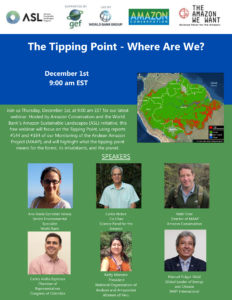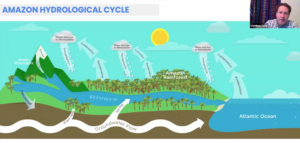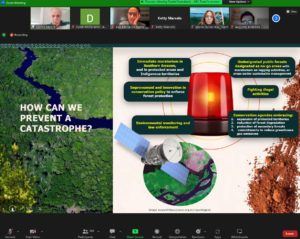The Tipping Point in the Amazon: Recap
December 2, 2022

On Thursday, December 1st, Amazon Conservation and the World Bank’s Amazon Sustainable Landscapes initiative co-hosted a webinar on the tipping point in the Amazon. The webinar featured expert panelists from government entities, conservation nonprofits, and indigenous groups.
The webinar brought to light some of the latest findings regarding what the tipping point actually is, how close we are to reaching it, and what that means for the Amazon, its inhabitants, and the world. It has been increasingly reported that the largest rainforest in the world, the Amazon, is rapidly approaching its tipping point. As highlighted by Carlos Nobre and our late Board Member and renowned scientist Tom Lovejoy, this tipping point is where parts of the rainforest will convert into drier ecosystems due to disrupted precipitation patterns and more intense dry seasons, both exacerbated by deforestation and climate change.
The impacts within the Amazon and beyond its boundaries can be catastrophic for both people and nature, upsetting a balance that local people have depended on for millennia as they shaped their lives around its climate, the economic foundation that its forests and waters make possible, and the ecosystem services (carbon sink, fresh water, etc.) that it provides to millions across a vast continent.
The Presenters

Dr. Matt Finer, Senior Research Specialist at Amazon Conservation and Director of MAAP, presented a novel look at the phenomenon and suggests that we should actually be thinking about 2 tipping points in the Amazon – the now well-known “point of no return” from a rainforest ecosystem to that of one more closely resembling a dry savanna, AND the Amazon going from a carbon sink to a carbon source.

To put this novel idea into perspective, attendees first heard from Dr. Carlos Nobre, premier meteorologist, ecologist, and co-chair of the Science Panel for the Amazon. Dr. Nobre explained that while we may be quickly approaching the tipping point, there are strategies to avoid reaching it, saying, “Restoring traditional forest functions and fusing new and traditional scientific knowledge will help us prevent a catastrophic tipping point. Recognizing and enforcing indigenous rights is critical.”
Attendees also heard from Carlos Ardila Espinosa, Representative from the Congress of Colombia, who provided invaluable insight into how conservation efforts are conceptualized in legislation. Representative Espinosa offered an example from the Putumayo department of Colombia where it is already evident that acknowledging and respecting indigenous peoples’ rights to their own territories allows not only restorative transformations to the forest to occur; but also provides the space for more diverse forest-based economies to take hold which ultimately fosters forest conservation. Representative Espinosa offered this important question, “How can we raise the value of 1 hectare of forest to equal or surpass 1 hectare that has been cleared for pasture? This is an integral hurdle to incentivizing conservation in legislation.”
Ana María González Velosa, Senior Environmental Specialist with the World Bank provided moderation for the event and Manuel Pulgar-Vidal, fresh home from attending the COP27 in Egypt, left attendees with his closing remarks emphasizing the urgency with which conservation in the Amazon must be addressed.

